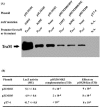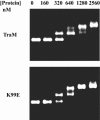Mutations in the C-terminal region of TraM provide evidence for in vivo TraM-TraD interactions during F-plasmid conjugation
- PMID: 15995191
- PMCID: PMC1169504
- DOI: 10.1128/JB.187.14.4767-4773.2005
Mutations in the C-terminal region of TraM provide evidence for in vivo TraM-TraD interactions during F-plasmid conjugation
Abstract
Conjugation is a major mechanism for disseminating genetic information in bacterial populations, but the signal that triggers it is poorly understood in gram-negative bacteria. F-plasmid-mediated conjugation requires TraM, a homotetramer, which binds cooperatively to three binding sites within the origin of transfer. Using in vitro assays, TraM has previously been shown to interact with the coupling protein TraD. Here we present evidence that F conjugation also requires TraM-TraD interactions in vivo. A three-plasmid system was used to select mutations in TraM that are defective for F conjugation but competent for tetramerization and cooperative DNA binding to the traM promoter region. One mutation, K99E, was particularly defective in conjugation and was further characterized by affinity chromatography and coimmunoprecipitation assays that suggested it was defective in interacting with TraD. A C-terminal deletion (S79*, where the asterisk represents a stop codon) and a missense mutation (F121S), which affects tetramerization, also reduced the affinity of TraM for TraD. We propose that the C-terminal region of TraM interacts with TraD, whereas its N-terminal domain is involved in DNA binding. This arrangement of functional domains could in part allow TraM to receive the mating signal generated by donor-recipient contact and transfer it to the relaxosome, thereby triggering DNA transfer.
Figures





Similar articles
-
Structural basis of specific TraD-TraM recognition during F plasmid-mediated bacterial conjugation.Mol Microbiol. 2008 Oct;70(1):89-99. doi: 10.1111/j.1365-2958.2008.06391.x. Epub 2008 Aug 19. Mol Microbiol. 2008. PMID: 18717787
-
Thirty-eight C-terminal amino acids of the coupling protein TraD of the F-like conjugative resistance plasmid R1 are required and sufficient to confer binding to the substrate selector protein TraM.J Bacteriol. 2004 Oct;186(20):6999-7006. doi: 10.1128/JB.186.20.6999-7006.2004. J Bacteriol. 2004. PMID: 15466052 Free PMC article.
-
The F plasmid-encoded TraM protein stimulates relaxosome-mediated cleavage at oriT through an interaction with TraI.Mol Microbiol. 2007 Feb;63(4):1173-84. doi: 10.1111/j.1365-2958.2006.05576.x. Mol Microbiol. 2007. PMID: 17238924
-
Relaxosome function and conjugation regulation in F-like plasmids - a structural biology perspective.Mol Microbiol. 2012 Aug;85(4):602-17. doi: 10.1111/j.1365-2958.2012.08131.x. Epub 2012 Jul 13. Mol Microbiol. 2012. PMID: 22788760 Review.
-
F conjugation: back to the beginning.Plasmid. 2013 Jul;70(1):18-32. doi: 10.1016/j.plasmid.2013.03.010. Epub 2013 Apr 28. Plasmid. 2013. PMID: 23632276 Review.
Cited by
-
Caught in the act: the dialogue between bacteriophage R17 and the type IV secretion machine of plasmid R1.Mol Microbiol. 2011 Dec;82(5):1039-43. doi: 10.1111/j.1365-2958.2011.07870.x. Epub 2011 Oct 24. Mol Microbiol. 2011. PMID: 22023392 Free PMC article.
-
Biological diversity of prokaryotic type IV secretion systems.Microbiol Mol Biol Rev. 2009 Dec;73(4):775-808. doi: 10.1128/MMBR.00023-09. Microbiol Mol Biol Rev. 2009. PMID: 19946141 Free PMC article. Review.
-
The Legionella pneumophila replication vacuole: making a cosy niche inside host cells.Nat Rev Microbiol. 2009 Jan;7(1):13-24. doi: 10.1038/nrmicro1967. Epub 2008 Nov 17. Nat Rev Microbiol. 2009. PMID: 19011659 Free PMC article. Review.
-
Alpha-Helical Protein KfrC Acts as a Switch between the Lateral and Vertical Modes of Dissemination of Broad-Host-Range RA3 Plasmid from IncU (IncP-6) Incompatibility Group.Int J Mol Sci. 2021 May 5;22(9):4880. doi: 10.3390/ijms22094880. Int J Mol Sci. 2021. PMID: 34063039 Free PMC article.
-
Error-prone PCR mutagenesis reveals functional domains of a bacterial transcriptional activator, TraJ.J Bacteriol. 2012 Jul;194(14):3670-7. doi: 10.1128/JB.00312-12. Epub 2012 May 4. J Bacteriol. 2012. PMID: 22563049 Free PMC article.
References
-
- Beranek, A., M. Zettl, K. Lorenzoni, A. Schauer, M. Manhart, and G. Koraimann. 2004. Thirty-eight C-terminal amino acids of the coupling protein TraD of the F-like conjugative resistance plasmid R1 are required and sufficient to confer binding to the substrate selector protein TraM. J. Bacteriol. 186:6999-7006. - PMC - PubMed
-
- Boltner, D., and A. M. Osborn. 2004. Structural comparison of the integrative and conjugative elements R391, pMERPH, R997, and SXT. Plasmid 51:12-23. - PubMed
-
- Byrd, D. R., and S. W. Matson. 1997. Nicking by transesterification: the reaction catalysed by a relaxase. Mol. Microbiol. 25:1011-1022. - PubMed
-
- Cabezon, E., J. I. Sastre, and F. de la Cruz. 1997. Genetic evidence of a coupling role for the TraG protein family in bacterial conjugation. Mol. Gen. Genet. 254:400-406. - PubMed
Publication types
MeSH terms
Substances
LinkOut - more resources
Full Text Sources

